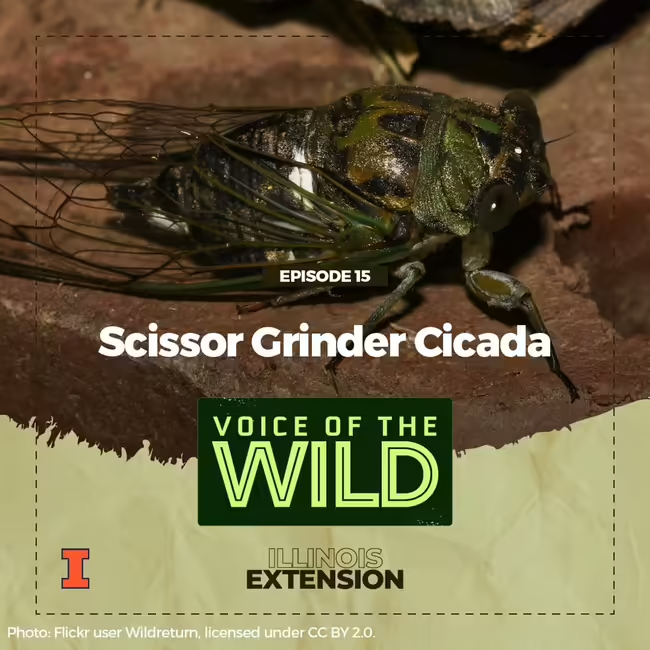
Episode Number
15
Episode Show Notes / Description
Scissor Grinder Cicada (Neotibicen pruinosus).
The scissor grinder’s name was a little more appropriate when it was common practice to sharpen cutting implements with a specialty grinding stone, now the name is a bit anachronistic. Unlike the small, orange-winged periodical cicadas, the Scissor Grinder Cicada can be heard every year. In Illinois, it emerges a little after the summer solstice and graces hot summer evenings with its oscillating call all the way through to the fall.
Do you want to learn more bird songs, frog calls, and insect noises? Join Voice of the Wild every Friday to explore a new wild voice. From time to time, we’ll also do a deep dive into wildlife science, news, and natural history. Voice of the Wild is brought to you by the University of Illinois Extension Natural Resources, Environment, and Energy program.
Available on most podcast platforms, including Apple Podcasts, Spotify, and YouTube.
Subscription links Here
Subscribe to the Newsletter
Listen online on our Homepage
Scissor Grinder Cicada audio recorded by Brodie Dunn
Sources and more:
- Common True Katydid. Songs of Insects. Available from http://songsofinsects.com/katydids/common-true-katydid.
- Common True Katydid. Missouri Department of Conservation. Available from https://mdc.mo.gov/discover-nature/field-guide/common-true-katydid.
- Common True Katydid (Pterophylla camellifolia). Singing Insects of North America (SINA). Available from https://orthsoc.org/sina/141a.htm.
Transcript
This is Illinois Extension’s Voice of the Wild. A new wild voice in just a moment, so find someplace quiet, take a deep breath, and enjoy.
Unlike the small, orange-winged periodical cicadas, which only emerge every thirteen or seventeen years, this annual cicada can be heard every year. In Illinois, it emerges little after the summer solstice and graces hot summer evenings with its oscillating call all the way through to the fall. They tend to stick to the treetops but can occasionally be found at eye level. There you can see their black abdomen, white stripe on their side, and the intricate green patterns on their back.
This is the scissor grinder cicada; Neotibicen pruinosus from the family of cicadas Cicadidae, This family of insects is in the order of true bugs, hemiptera.
The scissor grinder’s name was a little more appropriate when it was common practice to sharpen cutting implements with a specialty grinding stone, now the name is a bit anachronistic. You’ll just have to imagine the sound of the knifegrinder passing a pair of scissors back and forth across the surface of the stone. To help you along, here’s that scissor grinder cicada again.
Thank you for tuning in to learn a new wild voice with Illinois Extension
Unlike the small, orange-winged periodical cicadas, which only emerge every thirteen or seventeen years, this annual cicada can be heard every year. In Illinois, it emerges little after the summer solstice and graces hot summer evenings with its oscillating call all the way through to the fall. They tend to stick to the treetops but can occasionally be found at eye level. There you can see their black abdomen, white stripe on their side, and the intricate green patterns on their back.
This is the scissor grinder cicada; Neotibicen pruinosus from the family of cicadas Cicadidae, This family of insects is in the order of true bugs, hemiptera.
The scissor grinder’s name was a little more appropriate when it was common practice to sharpen cutting implements with a specialty grinding stone, now the name is a bit anachronistic. You’ll just have to imagine the sound of the knifegrinder passing a pair of scissors back and forth across the surface of the stone. To help you along, here’s that scissor grinder cicada again.
Thank you for tuning in to learn a new wild voice with Illinois Extension